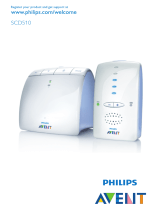
21
transmit indicator (8) goes out.
5. This baby monitor is equipped with an out-of-range alert function. The baby unit transmits an
acoustic signal to the parent unit at regular intervals even when the microphone (5) does not
pick up any sound.
6. If you wish to set the night light (1) ON permanently, set the Power ON-OFF switch (4) to
position .
7. The battery status is shown by the POWER ON/BATTERY LOW indicator (9). When the battery
power begins to weaken, the BATTERY LOW indicator (9) starts ashing. Insert a new battery or
use the switching power supply.
8. The temperature sensor (11) measures the temperature in the baby’s room and sends a signal to
the parent unit. To ensure correct reading, do not block the ventilation of this sensor.
8.2. PARENT UNIT (RECEIVER)
1. Set the Power ON-OFF switch (15) to ON. The POWER ON indicator (19) lights up wellow.
2. Place the parent unit a reasonable distance away from the baby unit to avoid feedback. If they
are too close, a screeching sound will emit from the speaker (22).
3. Once the unit receives a signal, the LEDs in the LEVEL METER (16) light up. The louder the baby’s
voice, the more LEDs light up. This feature is useful in cases where you prefer to turn down the
speaker volume to keep the environment quiet.
4. The speaker volume can be adjusted by using the VOLUME UP/DOWN buttons (13) & (14).
Each time a button is pressed, a beep sound is issued and
to light up respectively in the
temperature indicator (20). means the speaker is muted and means maximum volume.
5. This unit is equipped with a vibration alert. Set the Power ON/OFF switch (15) to
position,
the vibration indicator (18) lights up. Once baby’s voice is received, the vibration alert starts
functioning. This feature is useful when you are working in a noisy environment (e.g. vacuum
cleaning). To save battery power, it is recommended not to use the vibration alert frequently.
6. When the parent unit has been beyond the communication range of baby unit for over 2
minutes, an out-of-range alarm is issued and the LED level meter (16) starts ashing to alert the
parents. The alarm only stops when the parent unit re-enters the communication range of baby
unit.
Note:
This alarm is also sounded in case the baby unit is switched o, its battery is weak, its
power is cut o or the pairing process is not successful.
7. The status of the battery power (or rechargeable battery pack) is displayed by the POWER ON/
BATTERY LOW indicator (19). When the battery begins to weaken, the indicator (19) starts to
ash and an alarm is issued, reminding you to replace the battery (or charge the battery pack
using the rapid charger).












